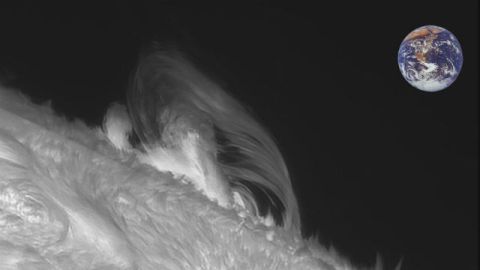Sun and Prominence

Do you live in a chilly northern climate? Then don’t be surprised to see some bright auroras in the night sky. Dramatic prominences from the sun are expelling hot gas into the solar system and hitting Earth. And this can trigger auroras.
NASA released an arresting image of a prominence on the surface of the Sun and explains:
Dramatic prominences can sometimes be seen looming just beyond the edge of the sun. Such was the case last week as a large prominence, visible above, highlighted a highly active recent Sun. A waving sea of hot gas is visible in the foreground chromosphere in great detail as it was imaged in one specific color of light emitted by hydrogen. A solar prominence is a cloud of solar gas held just above the surface by the Sun’s magnetic field. The Earth, illustrated in the inset, is smaller than the prominence. Although very hot, prominences typically appear dark when viewed against the Sun, since they are slightly cooler than the photosphere below them. A quiescent prominence typically lasts about a month, and may erupt in a Coronal Mass Ejection (CME) expelling hot gas into the Solar System, some of which may strike the Earth and trigger auroras.





